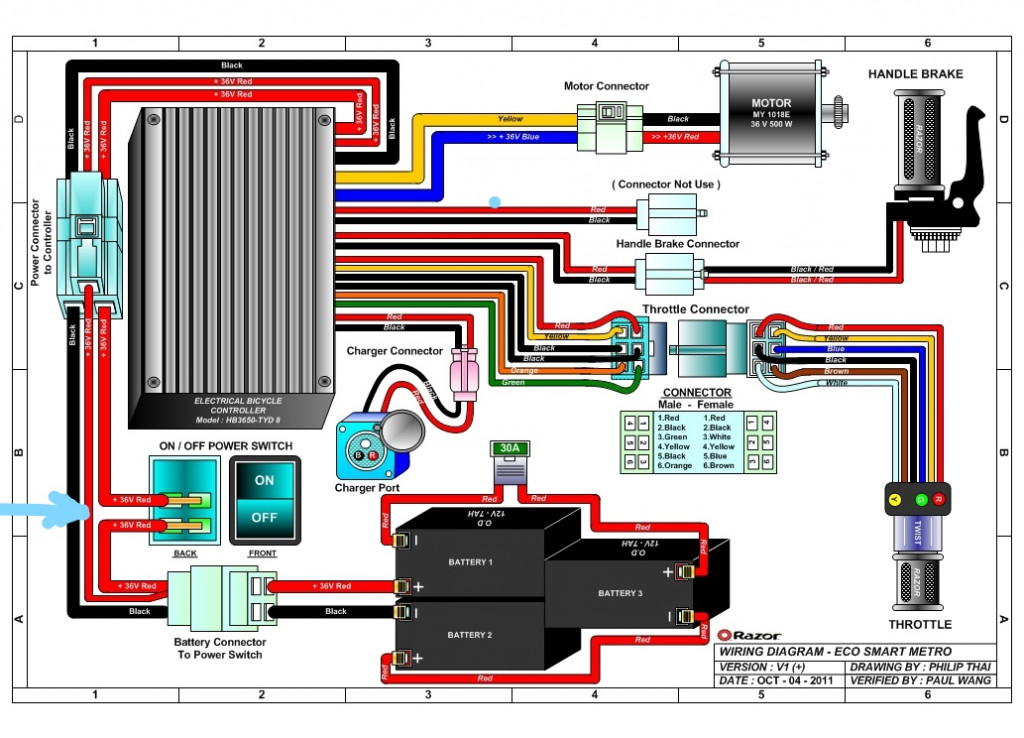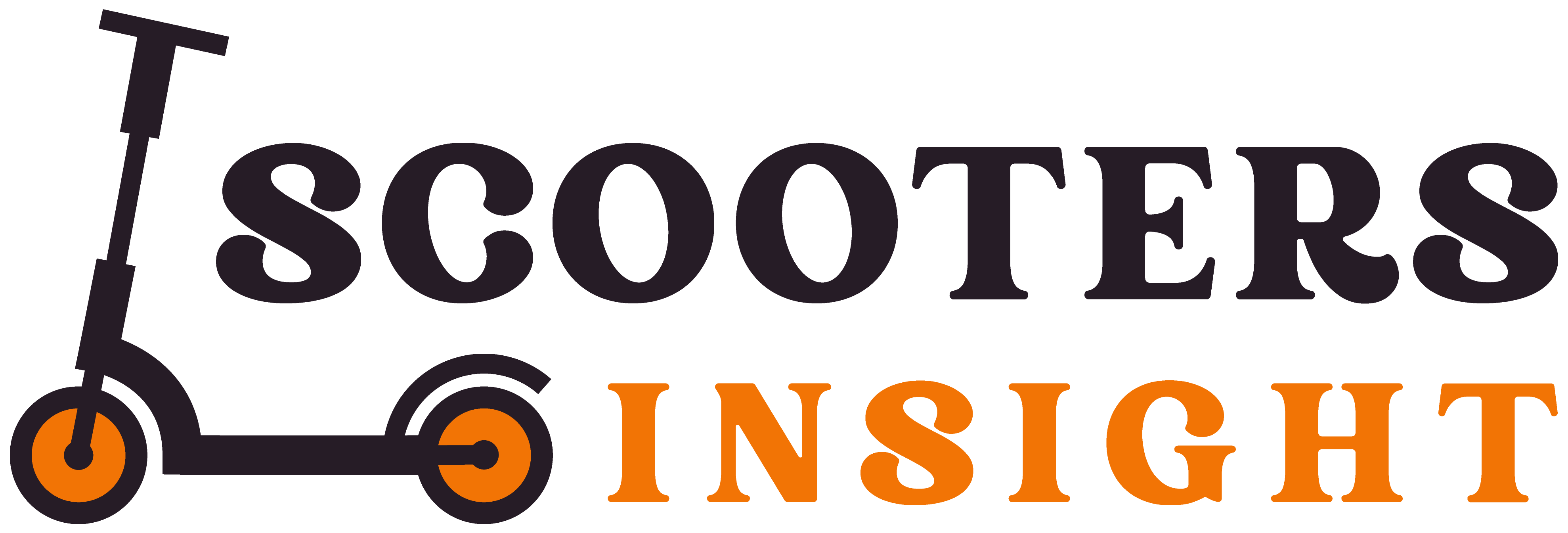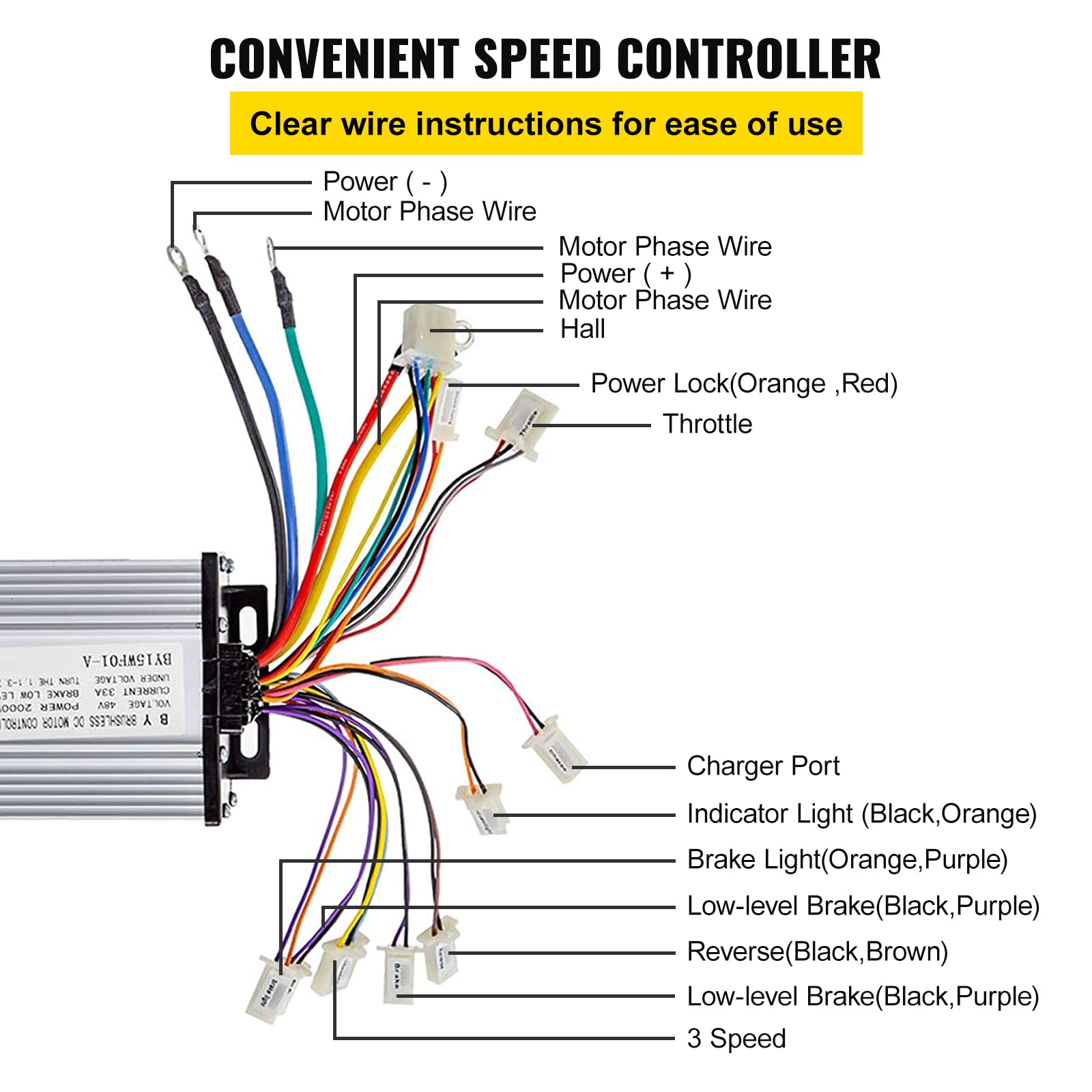The Electric Scooter Throttle Wiring Diagram can help troubleshoot issues with an electric scooter’s throttle and speed controller. It is vital to ensure proper wiring connections between the throttle and speed controller for the scooter to function correctly.
These diagrams provide step-by-step instructions on how to wire the throttle to the speed controller, aiding in a successful wiring setup. By following the diagram, users can effectively connect the throttle and speed controller, ensuring proper functionality of the electric scooter.
Introduction To Electric Scooter Throttle Wiring Diagram
The Electric Scooter Throttle Wiring Diagram provides a visual guide on how to connect the throttle to the speed controller for an electric scooter. It helps troubleshoot common issues related to throttle functionality and assists in understanding the wiring setup for proper operation.
An electric scooter throttle is a crucial component that controls the speed and acceleration of an electric scooter. Understanding the wiring diagram of the throttle is essential for troubleshooting and fixing any issues that may arise. In this section, we will explore what an electric scooter throttle is, the importance of understanding throttle wiring, and common issues that can occur with electric scooter throttles.
What Is An Electric Scooter Throttle?
An electric scooter throttle is a device that allows the rider to control the speed and acceleration of the scooter. It is typically connected to the handlebars and is operated by the rider’s hand. The throttle sends signals to the scooter’s controller, which regulates the power supplied to the motor based on the position of the throttle. This determines the scooter’s speed and acceleration.
Importance Of Understanding Throttle Wiring
Understanding throttle wiring is important for several reasons. Firstly, it allows for proper installation and connection of the throttle to the scooter’s controller. Incorrect wiring can result in malfunctioning or unpredictable behavior of the scooter. Secondly, knowing the wiring diagram enables effective troubleshooting in case of issues with the throttle. It helps identify and fix any loose connections, faulty wires, or damaged components. Lastly, understanding throttle wiring allows for customization and upgrades, as riders can replace the throttle or modify its wiring to meet their specific requirements.
Common Issues With Electric Scooter Throttles
Electric scooter throttles can experience various issues that can affect their functionality. Some common problems include:
- Throttle not working: This can be due to a faulty throttle or a short circuit in the throttle cable. Disconnecting the throttle from the speed controller can help determine the cause.
- Inconsistent speed control: If the scooter’s speed is not responding accurately to the throttle input, it could indicate a problem with the wiring or the throttle itself.
- Throttle sticking: The throttle may get stuck in a particular position, causing the scooter to maintain a constant speed or accelerate unexpectedly.
- Intermittent connection: Loose or damaged wiring connections can result in intermittent signal transmission, leading to sporadic throttle response or complete loss of control.
Being aware of these common issues and their potential causes can help scooter riders diagnose and resolve problems with the throttle more effectively.
Components Of An Electric Scooter Throttle
The electric scooter throttle is an essential component that controls the speed and acceleration of the scooter. It consists of several key components that work together to ensure smooth and efficient operation. In this section, we will explore the different parts of an electric scooter throttle and their functions.
Throttle Grip
The throttle grip is the part of the scooter’s handlebar that the rider holds onto and uses to control the speed. It is typically made of rubber or another comfortable material for a firm and comfortable grip. The throttle grip is designed to twist or rotate, allowing the rider to increase or decrease the speed of the scooter.
Throttle Cable
The throttle cable is responsible for transmitting the movement of the throttle grip to the speed controller of the scooter. It connects the throttle grip to the speed controller, allowing the rider’s input to be translated into the desired speed. The throttle cable is made of durable materials to withstand continuous use and ensure a reliable connection between the throttle grip and the speed controller.
Throttle Connector
The throttle connector is the interface between the throttle cable and the speed controller. It ensures a secure and proper connection, allowing the electrical signals to be transmitted accurately. The throttle connector is typically a plug-and-play component that can be easily connected or disconnected, making it convenient for maintenance or replacement.
Throttle Wiring
The throttle wiring consists of the electrical wires that carry the signals from the throttle grip to the speed controller. These wires are responsible for sending the information about the desired speed and acceleration to the speed controller, which then adjusts the scooter’s motor accordingly. The throttle wiring is typically color-coded to ensure proper connection and troubleshooting.
In conclusion, the components of an electric scooter throttle, including the throttle grip, throttle cable, throttle connector, and throttle wiring, work together to provide the rider with control over the speed and acceleration of the scooter. Understanding these components is crucial for maintaining and troubleshooting electric scooter throttle issues.
Understanding Electric Scooter Throttle Wiring
An electric scooter’s throttle wiring is a crucial component that connects the throttle to the speed controller, allowing riders to control the scooter’s speed. In this article, we will discuss the basic wiring diagram of an electric scooter throttle, the connection between the throttle and the speed controller, and troubleshooting techniques for faulty wiring.
Basic Wiring Diagram
The basic wiring diagram of an electric scooter throttle consists of several components:
- Throttle: The throttle is the input device that the rider uses to control the scooter’s speed. It is usually a twist-grip or thumb throttle.
- Speed Controller: The speed controller is responsible for regulating the flow of power from the battery to the motor based on the input received from the throttle.
- Battery: The battery supplies the power needed to operate the electric scooter.
- Motor: The motor converts electrical energy into mechanical energy, propelling the scooter forward.
When the rider twists or presses the throttle, it sends a signal to the speed controller, which then adjusts the power output to the motor accordingly. This allows the scooter to accelerate or decelerate based on the rider’s input.
Connection Between Throttle And Speed Controller
The throttle and speed controller are connected using a set of wires. The specific wiring configuration may vary depending on the scooter model, but the general principle remains the same:
- The throttle is typically equipped with three wires: a red wire for +5V power supply, a black wire for ground, and a signal wire (often green or yellow) that carries the throttle’s input signal.
- The speed controller is usually equipped with corresponding wires to connect to the throttle. These wires are color-coded to match the throttle’s wires, simplifying the connection process.
- The red wire from the throttle is connected to the +5V power supply wire on the speed controller.
- The black wire from the throttle is connected to the ground wire on the speed controller.
- The signal wire from the throttle is connected to the input signal wire on the speed controller.
It’s crucial to ensure that the wiring connections are secure and properly insulated to avoid any electrical faults or short circuits that could lead to malfunctioning of the scooter.
Troubleshooting Faulty Wiring
If you encounter issues with your electric scooter’s throttle wiring, it’s essential to troubleshoot the problem to identify and rectify any faulty connections. Here are a few steps you can follow:
- Check for loose connections: Ensure that all wiring connections between the throttle and speed controller are secure and properly tightened.
- Inspect for damaged wires: Look for any signs of wire damage such as cuts, frayed ends, or exposed conductors. If you find any, replace the damaged wires or seek professional assistance.
- Test the throttle: Disconnect the throttle from the speed controller and test it separately. If the motor stops running, it indicates a defective throttle; if the motor continues to run constantly, then the speed controller may be defective.
By following these troubleshooting steps and ensuring proper wiring connections, you can maintain the optimal performance of your electric scooter and enjoy a smooth riding experience.
Step-by-step Guide To Wiring An Electric Scooter Throttle
Learn how to wire an electric scooter throttle with our step-by-step guide. Avoid common mistakes by following our easy-to-understand instructions. Increase the efficiency of your electric scooter with proper throttle wiring.
## Step-by-Step Guide to Wiring an Electric Scooter Throttle
### Selecting the right throttle for your scooter
When it comes to wiring an electric scooter throttle, selecting the right throttle for your scooter is the first step. A throttle is a device that controls the speed of your electric scooter. There are different types of throttles available in the market, such as thumb throttles, twist throttles, and half-grip throttles. It’s important to choose a throttle that is compatible with your scooter’s make and model.
To select the right throttle for your scooter, follow these steps:
1. Determine the type of throttle your scooter needs.
2. Check the voltage and current rating requirements of your scooter’s motor.
3. Research different throttle options and compare their specifications.
4. Choose a throttle that matches your scooter’s voltage and current rating requirements.
### Identifying the wiring colors and connections
Once you have selected the right throttle for your scooter, the next step is to identify the wiring colors and connections. This will ensure that you connect the throttle correctly to your scooter’s speed controller.
Follow these steps to identify the wiring colors and connections:
1. Consult your scooter’s owner manual or wiring diagram for guidance.
2. Locate the throttle’s wiring harness and identify the wires.
3. Typically, throttle wiring consists of three wires: red (power), black (ground), and green (signal).
4. Use a multimeter or continuity tester to confirm the function of each wire.
5. Check the wiring diagram or manual to determine which wire connects to the corresponding terminal on the speed controller.
### Securing and insulating the wiring
Now that you have identified the wiring colors and connections, it’s time to secure and insulate the wiring. This step is crucial to ensure a safe and reliable connection between the throttle and speed controller.
Follow these steps to secure and insulate the wiring:
1. Use cable ties or adhesive tape to secure the wiring along the frame of your scooter.
2. Make sure that the wiring is not loose or exposed to prevent any potential hazards.
3. Insulate each wire connection using heat shrink tubing or electrical tape.
4. Slide the heat shrink tubing over the wire connection and use a heat source, such as a heat gun or lighter, to shrink the tubing and create a tight seal.
5. Alternatively, wrap electrical tape tightly around the wire connection to provide insulation.
By following these step-by-step guidelines, you can successfully wire an electric scooter throttle to your scooter’s speed controller. Remember to exercise caution and refer to your scooter’s wiring diagram or manual for specific instructions.
Tips For Maintaining Electric Scooter Throttle Wiring
Proper maintenance of the electric scooter throttle wiring is crucial for the smooth operation and longevity of your scooter. Regular inspection and cleaning of throttle components, avoiding water damage to the wiring, and replacing worn out or damaged wiring are essential steps in ensuring your electric scooter throttle functions optimally.
Regular Inspection And Cleaning Of Throttle Components
Regularly inspecting and cleaning the throttle components of your electric scooter is vital in preventing potential issues. Here are a few tips to follow:
- Start by visually inspecting the throttle wiring for any signs of wear, fraying, or damage. Replace any damaged wiring immediately to avoid further issues.
- Next, detach the throttle from the speed controller and carefully clean it using a soft cloth or brush. Remove any dirt, debris, or built-up grime that may interfere with the throttle’s functionality.
- Ensure that the throttle mechanism moves smoothly without any stiffness or resistance. Lubricate the moving parts if necessary, using an appropriate lubricant recommended by the manufacturer.
- Double-check all connections between the throttle, speed controller, and battery to ensure they are secure and free from corrosion. Tighten any loose connections as needed.
Avoiding Water Damage To The Wiring
Water damage is a common issue that can affect the functionality of your electric scooter throttle. To prevent this, follow these steps:
- Avoid riding your electric scooter in wet or rainy conditions whenever possible.
- If you do encounter water or moisture during your ride, promptly dry off the throttle and wiring using a soft cloth.
- Consider investing in a waterproof cover or protective sleeve for your throttle to provide an extra layer of protection against water damage.
Replacing Worn Out Or Damaged Wiring
Over time, the wiring of your electric scooter throttle may become worn out or damaged, compromising its functionality. Here’s what you need to do:
- Regularly inspect the wiring for any signs of wear, fraying, or damage. Common areas to examine include the connections at the throttle, speed controller, and battery.
- If you notice any issues with the wiring, such as exposed wires or loose connections, it’s crucial to replace them immediately.
- When replacing the wiring, ensure that you use compatible and high-quality replacement parts recommended by the manufacturer to maintain optimal performance.
- Follow the manufacturer’s instructions or seek professional assistance if needed to ensure proper installation and wiring connections.
By following these tips for maintaining electric scooter throttle wiring, you can prolong the lifespan of your scooter and enjoy a smooth and reliable ride every time.

Credit: electricscooterparts.com

Credit: forum.electric-scooter.guide
Frequently Asked Questions Of Electric Scooter Throttle Wiring Diagram
How Does A 3 Wire Electric Throttle Work?
A 3 wire electric throttle works by sending signals to the speed controller, which controls the acceleration and speed of the electric scooter. It typically consists of three wires that connect the throttle to the speed controller, allowing the rider to control the scooter’s speed by manipulating the throttle.
Why Does My Electric Scooter Turn On But Won’t Accelerate?
If your electric scooter turns on but won’t accelerate, it’s likely due to a worn-out or defective battery. Another possible culprit is a faulty throttle or a short circuit in the throttle cable. To troubleshoot, you can test the throttle by disconnecting it from the speed controller.
If the motor stops running, the throttle is defective. If the motor keeps running, the speed controller is the issue.
Why Is My Electric Scooter Throttle Not Working?
The most common reason for your electric scooter throttle not working is a faulty throttle or a short circuit in the throttle cable. To check if this is the issue, disconnect the throttle from the speed controller. If the motor stops running, then the throttle is defective.
If the motor continues to run constantly, then the speed controller is defective.
What Controls The Speed Of An Electric Scooter?
The speed of an electric scooter is controlled by the electric scooter controller, which is integrated into the handlebars or the scooter’s deck. It regulates speed, acceleration, and regenerative braking by connecting the scooter’s throttle and regen brake levers, battery, and motor(s).
Conclusion
To ensure your electric scooter is running smoothly, it’s crucial to understand the throttle wiring diagram. By carefully connecting the throttle to the speed controller, you can effectively control the speed and acceleration of your scooter. However, if you encounter issues with the throttle not working, it could be due to a faulty throttle or a short circuit.
By testing the throttle and speed controller, you can identify the source of the problem and make the necessary repairs. Wiring your electric scooter throttle may seem daunting at first, but with a step-by-step guide, you’ll be able to navigate the process easily.

